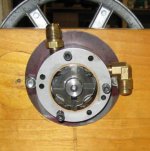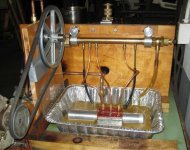I tend to look at a job like slotting the rotor of this vane pump by asking myself: "How would this part have been machined back in the 1900's ?". The answer is: most likely by means of a horizontal milling machine with a milling cutter 1/4" wide. In the 1900's such a cutter would be made from high carbon tool steel, as even high speed steel cutters were not in use, let alone carbides. A 1/4" wide milling cutter, perhaps ground a touch narrower than the final required width might have been used. The slots may well have been hand finished by filing to get the right fit and a smooth surface on the walls of the slots.
The era the Mitchell car was made and the car itself was not the era of large numbers of mass-produced automobiles. The car and its engine were built right around the time the Model T was getting into high production numbers. Most car builders were small and building their cars as almost one-off type things. Most of those small car builders did not survive into the era of making hundreds of cars, if not more, each day. It was an era when hand labor as part of the manufacturing processes was a given, and an era when the use of files to produce finished work was commonplace. My mind, in going back to this era, sees rows of bench vises and men using smooth-cut files to hand finish the slots in the pump rotors.
By way of a similar example: Indian Motorcycles, into the late 20's and early 30's, had great dimensional variations on certain machined surfaces in the crankcase halves and even on the crankshaft assembly (flywheels and crankpin) and connecting rods. Building one of those engines on the "production line" called for individual fitup of the parts, checking the fits, possibly having thrust washers surface ground to suit the as-assembled dimensions, and adjustments which included the use of lead hammers to true up a crankshaft. The Mitchell cars were not built in the numbers that Indian was building motorcycles, so hand filing of the rotor slots to fit the oil pump vanes would be highly likely.
Using pre-tempered clock spring material is a thought I also had for the leaf springs to hold out the vanes. When I first read the thread, I thought of using strips cut and ground from carbon steel bandsaw blade for the springs. I've made some light spring leaves for one-off jobs from scrapped carbon steel bandsaw blade stock. As I read further, I realized how small and light the springs have to be, so bandsaw blade material is way heavy for the job. "Blue Steel" clock spring material would have been in common use back "in the day", and is still available.
In reading this thread, the fact the Mitchell had an oil pump, let alone a vane type pump, in the era it was built is quite remarkable. Most auto engines of that time period had splash lubrication, or used "total loss" oiling for some of the working parts. Seeing what appears to be a fairly husky vane pump for the Mitchell engine's lubrication system says a lot about the design of that engine for the times.
On various jobs I get into, I find myself looking at certain parts or assemblies- whether they be machine work, or locomotive boiler work, to name a couple of types of jobs. In looking the jobs over, whether for determining "fitness for service", or designing repairs or alterations, I find myself asking: "How did 'they' build it back then ?". Some of the work I come across borders on the impossible and would have called for some real slick maneuvering, such as riveting some of the seams on a locomotive boiler firebox "wrapper" with the firebox in place. Some of the work called for silver brazing in an era predating oxy-fuel or TIG torches, and some of the machine work is plainly quite amazing for the machine tools and cutting tools available back then. It is easy to lose sight of the important role that filing and hand-fitting of machine parts played back in that era. Legions of men spent their working lives "at the bench", hand filing and fitting parts and hand assembling them.
The making of a machinist back in the day usually required a number of filing exercises, filing to dimensions and getting things square and parallel and true, and getting surfaces dead flat or nearly so. Machine shops had a row of bench vises, usually along a wall with good natural light for the machinists or fitters. Mitchell likely had something like this, and it is easy to visualize machinists hand filing rotor slots, matching up a set of vanes, and assembling the pumps as individual units.











